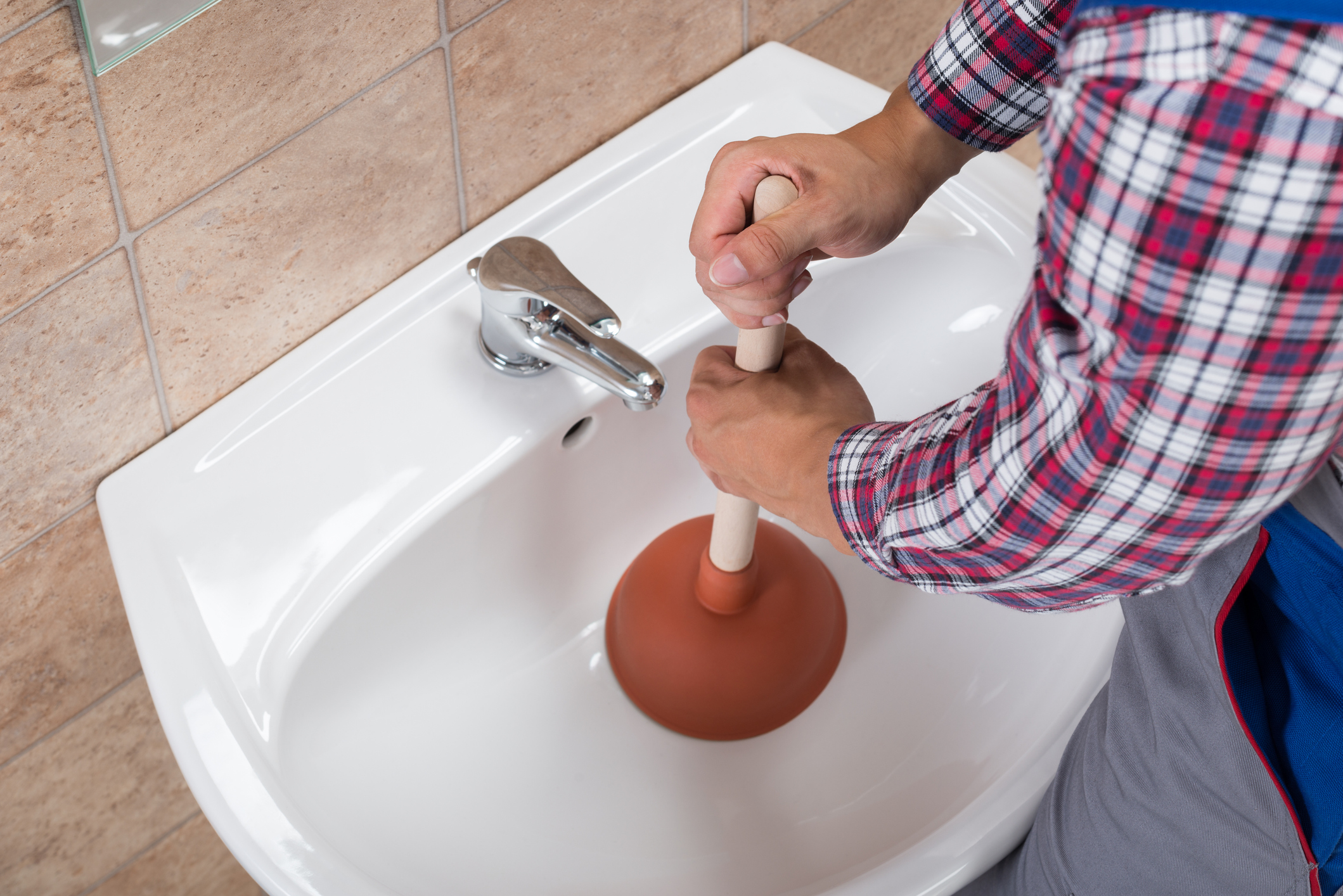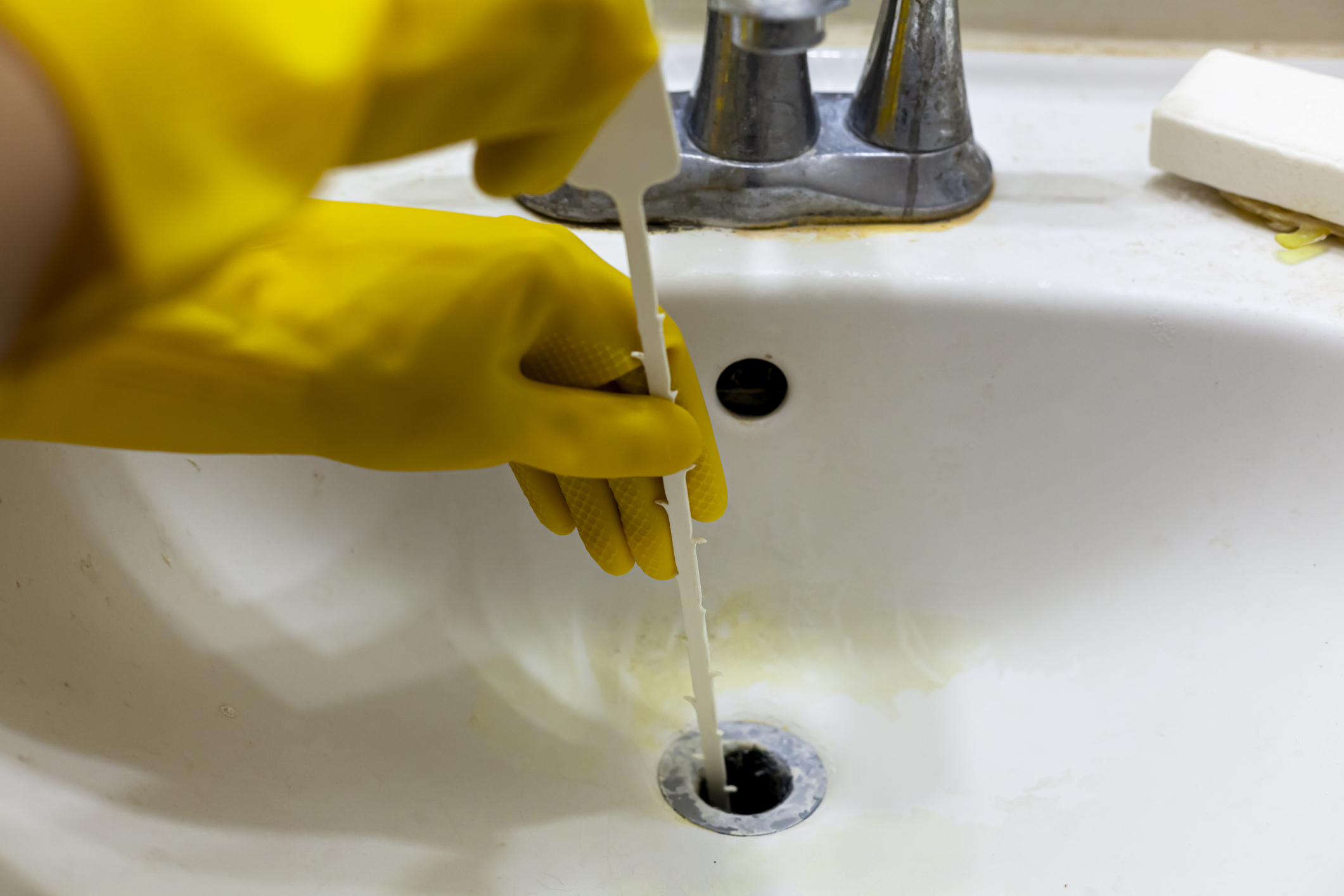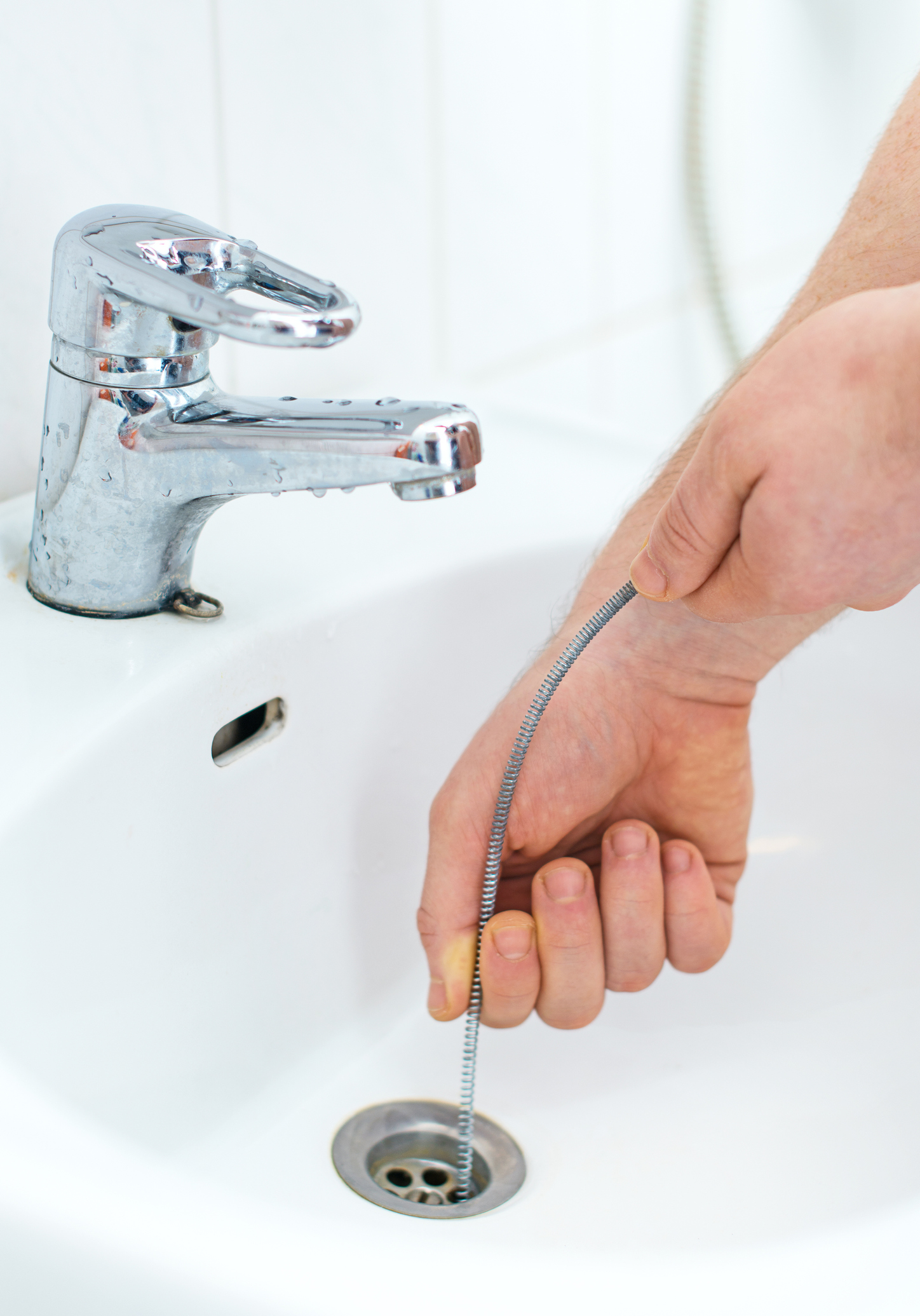How To Unblock A Bathroom Sink & Keeping it Clog Free

The last thing you want when you are using your bathroom sink, to rinse your face, have a shave or complete your daily make-up routine, is the smell of sewage wafting up from the plughole. Worse still is when, after you have finished your ablutions, your basin water begins draining sluggishly, or not at all, due to an unforeseen blockage.
Blockages are not only unpleasant on the senses, but can quickly become a burden in terms of time and even money if they are not easily fixable. Furthermore, the longer a blockage is left unchecked, the higher the possibility is that it might also be causing unseen damage to your system, resulting in the integrity of your sink deteriorating or the fitting breaking altogether, which can lead to more costly leaks.
This guide covers everything you need to know about blocked bathroom sinks, from why blockages occur to the essential task of how to unblock a basin, including some of the household hacks you can try and the pros and cons of each unblocking method.
- Why do Blocked Bathroom Sinks Occur?
- How to Prevent or Stop Blocked & Clogged Bathroom Sinks in the First Place?
- Hacks, Tips & Ways For Unblocking A Bathroom Sink
- What is the Cost of Clearing A Bathroom Sink Blockage?
Why do Blocked Bathroom Sinks Occur?
Blocked bathroom sinks can occur for a number of reasons, ranging from debris and material washed away during use, all the way to external factors such as the weather. We have summarised each of these reasons below:
Waste Materials From Daily Use
Probably the most common reason for blockages is the remnants of daily usage being washed down the plughole. The most frequent offender is the hair that stays in the plumbing and does not wash away immediately. Clusters of hair act like a net for other materials, catching them as they flow past, especially if the water flow is not sufficient to clear it from the system. Anything from more hair and shed skin, viscous liquids such as toothpaste, shampoos and soaps, to even dust and dirt from household cleaning can be caught in the hair trap hiding beneath your basin waste. This builds up, can even dry, and keep growing until the problem is enough to make it noticeable.
Thankfully, you should be able to resolve this problem easily enough without needing any help from a professional, and we will cover the details of this method later on in this guide.
Blockages in the Soil Pipe
It is worth remembering that all your fixtures and fittings are likely to be connected to the main soil pipe, which allows water to drain from them into the sewers. As such, if something is poured or flushed down the waste from a toilet or bathtub, this could cause a blockage which then backs up your whole system, including your bathroom basin.
It should not need reminding, but it is vitally important that nothing is washed or flushed down into the system that should not be there, or that cannot easily be degraded. This includes items of jewellery, tissue paper (if pushed down basins, urinals, or bathtubs), feminine products, nappies, cotton wool, and even edibles like chewing gum.
Poor Workmanship & Fitting
If the plumbing in your home was not installed by a qualified professional, or you suspect it might be a cheap bodged job undertaken by a previous homeowner, it may be that your plumbing system itself is not fit for the purpose. If you think the installation of your system might be contributing to your blocked sink, or preventing water from draining effectively due to wrongly angled pipework, then it may take more than a few home hacks to resolve the problem.
If blockages are becoming a recurring issue, then it may be worth asking a professional to review and provide a second opinion on the plumbing to make sure it is adequately fitted. This should help you to decide whether it is worth persisting with your current system or whether these blockages point to a long-term issue that needs urgently resolving.
Bad Weather, Blocked Drains & Sewers
As frustrating as those nose-wrinkling smells can be, they may not always be the fault of your own system. Although water companies spend time shifting nuisance blockages and freeing ‘fatbergs’ from the pipeline, these actions do not always prevent water from backing up. In fact, drainage problems and odorous plugholes are more likely to occur after a period of bad weather, particularly heavy downpours that put the entire sewage system under pressure. Not only is the impact of your ordinary household usage bolstered by significant extra water flow, but bad weather can also increase the chances of blockages in the system due to materials from outside being washed down drains, such as mud, dirt and leaves, which then backs up into the home.
In these situations, unfortunately there is nothing you can do except wait it out. Some water companies do offer paid for services that may alleviate issues in the interim. If you have a drain cover outside, they may be able to send someone to inspect the system to make sure it is still working effectively, or remove blockages if every solution has been tried internally and the problem occurs more frequently than just in bad weather.
How to Prevent or Stop Blocked & Clogged Bathroom Sinks in the First Place?
Now that we have diagnosed all the potential issues, now we can move onto our discussion of how to prevent them before they arise. The most effective precaution you can take is to be wary about what is going down the bathroom sink in the first place. If you live in a busy household, it can be hard to moderate other users but ensuring that anyone follows some basic rules will help prevent blockages, as well as be kinder to the system on the whole so that it lasts longer. Here are some quick tips:
- If you have a traditional plug and chain waste, getting a hair catcher that can be placed over the plug hole can help catch hair and dirt when in use.
- If you have a more modern waste, such as a click clack basin waste that can be unscrewed, removing it and keeping your waste clean can help prevent blockages further down in the pipework.
- Clean your drains regularly.
- Shave your body hair regularly and brush your hair (particularly if you have longer hair) before washing to remove any hair that is already damaged or loose that fight fall into your sink.
- Make sure not to drop thick toothpaste or push dried toothpaste down the sink. Always rinse away thoroughly when brushing teeth to ensure that no remnants are left behind.
It is just not practical, both from a time and cost perspective, to perform routine maintenance or to keep ripping out pipework every few years. As such, protecting your pipes and sink fittings by following the rules outlined above is vitally important for long term peace of mind.
Hacks, Tips & Ways For Unblocking A Bathroom Sink
There are a number of quick and easy solutions that you can try, as a preventative measure and to unblock a bathroom sink if it is already clogged. We have summarised each one below, as well as providing a step-by-step guide of what to do and what you will need. It may also be worth acquiring or keeping the following essential tools on hand:
- Plunger
- Rubber Gloves or Marigolds
- Towels
- Tools such as spanners, pliers and anything else that can help tighten loose fittings
- Something to grab blockages, like a plumber’s snake, a wire coat hanger, pipe cleaners, augers, a Zip It Drain Cleaner or similar Drain Snake or Brush.
Unblock A Bathroom Sink With A Plunger
All you will need for this is arm strength and perseverance. If the blockage is in the upper part of the waste, this can be moved through the vacuum created by trapping the air in the pipe.

- Firstly, block the overflow if you have one with a cloth to prevent air escaping. Remove the basin waste if this can also be done.
- Make sure you have enough sitting water in the basin to cover part of the suction head or fill the space around it.
- Place the plunger over the plughole, making sure that there are no gaps for air to escape such that you have created a seal.
- Push the plunger up and down slowly and repeatedly for a few minutes.
- Release the plunger and repeat the process until the water drains effectively.
- If you can see what is causing the blockage, use something to grab and remove it.
- If this method does not work out, move on to the next solution.
Unblocking A Sink Without A Plunger
So, how exactly do you conquer a clogged bathroom sink without a plunger?
The Boiling Hot Water Method
One of the easiest ways of removing clogs from bathroom sinks is simply to use boiling hot water. However, make sure that your pipes aren’t made of plastic or PVC as this could cause extra damage. Boiling hot water can help move clogs, as well as removing lingering dirt and residue. To do this:
- Boil hot water in a kettle or saucepan.
- Pour the boiling water down the drain.
- Repeat several times until the water drain effectively.
Baking Soda and ̶̶Vi̶n̶e̶g̶a̶r̶ Water
A common household hack, for creating what is considered an effective cleaning solution, is the combination of bicarbonate of soda (or baking soda) and white vinegar, which can help in lifting dirt from surfaces. The acid of the vinegar combines with the soda to foam up and create carbon dioxide. However, when it comes to unblocking pipes, its effectiveness is actually questionable. Experts suggest using water instead of white vinegar, as the vinegar cancels out the baking soda and weakens its effect. To use baking soda and water:
- Boil water in a kettle or on the hob in a saucepan.
- Take some bicarbonate of soda or baking soda and sprinkle down the drain plain.
- Pour the hot water down the drain.
- Repeat the process for second time.
- Flush through with plain hot water twice and leave for a short period of time.
- Test to see if the problem has been resolved.
Using A Plumber’s Snake or Auger
A handy contraption to have in any household, a plumber’s snake is a long cable that has a coiled, corkscrew-like end. This is fed into the drain manually or mechanically then rotates to move, disintegrate or pull out dirt and debris from any blockages along the way (or at least dislodge it until it flows away). As its name suggests, the plumber’s snake can even reach past the U-Bend and further down the drain if the blockage is further on. It is worth paying attention to the instructions on the one you have, as they can vary in their operation. However, the following steps should provide a rough overview:
- Unravel the plumber’s snake or auger and feed into the drain by hand, ensuring that it remains straight and does not bend.
- As you encounter any curves or bends in pipes or plumbing, lock the mechanism and rotate the handle clockwise to slowly feed it into the bend.
- Once passed, unlock the mechanism and continue feeding by hand until you encounter any blockages or the plumber’s snake as gone as far as it can go.
- Lock it completely and begin to rotate the handle again to catch the blockage or anything in its vicinity.
- Gently pull in the coil to retrieve the blockage and pull out any dirt along the way.
- Repeat as necessary or until the blockage is cleared.
Removing Traps & U-Bends
If you have exhausted all other options, or the clog is still not moving, then you may be down to your last resort: taking the plumbing apart. The waste trap, which is also called the P-Trap or U-Bend, is the section of pipework that the water goes through to reach the drain. Before attempting to remove your waste tap, it is important to note that its design retains water to prevent the smell of sewage rising up to your plughole. This may be slightly more messy than other tasks, so it is advisable to have these extra items on hand:
- A bucket to catch any water.
- Rags or towels to help with holding item.
To remove the waste trap:
- Turn the water off and clear everything from under your sink, to make space and avoid any water leaking onto any items.
- Place the bucket and towels underneath the basin to catch any water from the removed waste trap.
- Take photos and make a note of how the plumbing fits together so that you aren’t scrambling to work this out afterwards (or completely mess it up!).
- Use tools to loosen the grip of the waste on the basin or sink and have the bucket ready to catch any escaping water.
- Ensure to keep any extras, such as washers, seals and connections, within easy reach for when you need to put it back together.
- Once removed, check the U-Bend and clean out any debris or dirt inside it.
- Push the plumber’s snake or any kind of flexible wire down the exposed pipe to retrieve any other blockages, or remove the blockage with your fingers if it is within reach.
- Once clear, reassemble the trap and waste and connect them back to the basin, ensuring it is fully sealed.
- Turn the water back on and allow it to run gently to ensure there are no leaks. Once confident, run the water more forcefully to test to see if it is draining effectively.
Chemical Cleaners & Drain Solutions
There are also some off-the-shelf drain unblockers that can be purchased from the supermarket. These contain chemicals to remove, dissolve and even wear away clogs and hair. Which? Magazine conducted an experiment using some of the key ones in the UK, which tested their effectiveness. Off the shelf solutions may be your best bet for a first resort option before working your way through the other more manual options to see if they might resolve your issue. However, it is worth remembering that these products can be harmful and dangerous to certain bathroom fixtures, especially those with coloured finishes. As such, be extra careful when using them or look to use kinder and more sensitive methods first.
Bleach is another product with an effectiveness that is still open to interpretation. Some experts argue that it doesn’t work and is mainly used to help clean away bacteria than attack blockages, while others stand by it as a proven method.
Using Coca Cola or Pepsi
Another household hack that has worked for some homeowners is using a dark, carbonated drink like Coca Cola. We have all seen the effect that cola has on cleaning old coins, so it is no surprise that it might help with cleaning blockages. The reality is that, while pouring some cola down a bathroom sink may dislodge some of the dirt or blockage, it takes a while to work and may not clean it effectively enough. Feel free to try it for yourself, but don’t be surprised if it means reverting back to one of previous methods for the blockage to be completely removed.
What is the Cost of Clearing A Bathroom Sink Blockage?
Ongoing routine maintenance and cleaning should not cost you more than £20 every few months. This covers the cost of basics like a drain snake, which are affordable online, and cleaning products, plus the cost of boiling hot water.
If a serious blockage occurs, obviously the cost quickly escalates, requiring tools, equipment and if you can’t do it yourself, hiring a professional to come and assist you. This can cost anywhere between £50 for basic DIY tools, to £150-£200 if factoring in costs of a professional.
If the blockage is outside your home, this could cost upwards of £250 and even above £300, depending on call out charges, hourly rates and also the cost of the work itself.
We hope this guide provides some helpful handy hints and tips on how to unblock your bathroom sink. If you have any hacks or ways that work for you that we have missed, get in touch and let us know.

